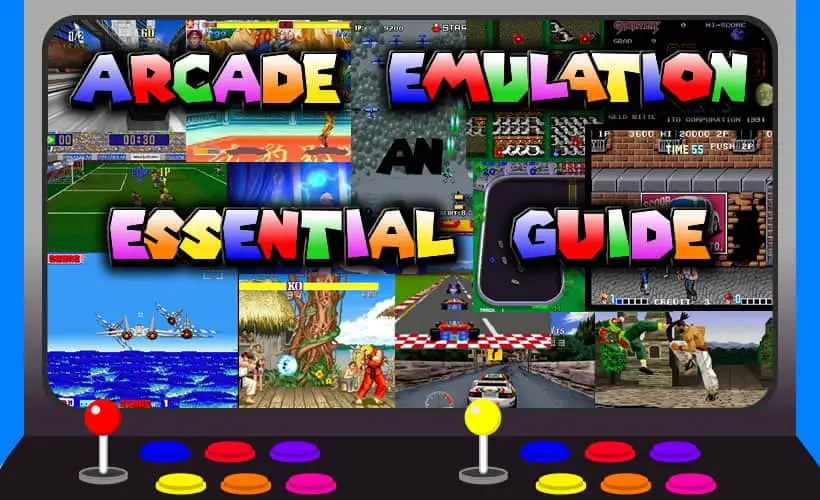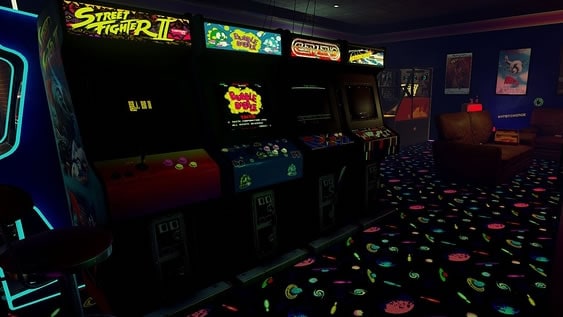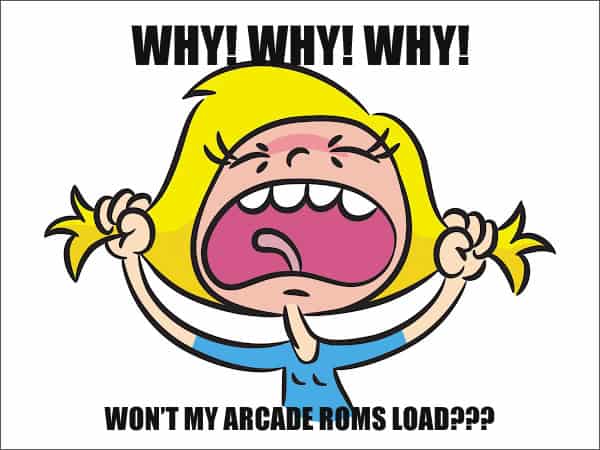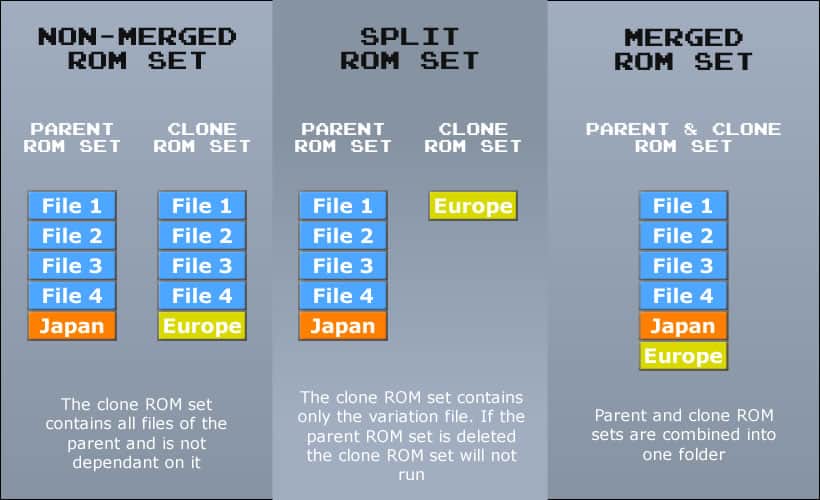
Arcade Emulation – An Essential Guide
For many retro gaming enthusiasts such as myself, arcade emulation can be the pinnacle of gaming enjoyment. Back in the days when I was a sprightly young lad it was not uncommon to find me down at the local sports centre, not exercising as I probably should have been, but feeding my hard earned pocket money into one of the few arcade cabinets that lined the corridors. Fast forward a few decades and I can still be found in front of a screen displaying classic arcade titles, except this time the screen is in my home and my spare change remains securely situated in my trouser pocket (or down the back of the sofa).

We are so fortunate in today’s world to be able to have free access to so many of our old arcade favourites, however the journey that leads to such a devine nirvana is fraught with hair tearing frustration and mind boggling confusion. Unfortunately for many people playing arcade games on an emulator is not as straightforward as they first envisaged.
To enter the world of arcade game emulation is to enter a confusing maze of back tracks, dead ends and general disappointment. If you manage to progress beyond the initial setbacks you will encounter numerous confusing terms such as MAME, CPS-2 and non-merged, and you will find few resources that assist you in achieving your goal – that being the holy grail of being able to play all your arcade favourites at the touch of a button.
In this article I will endeavour to provide you with the essential knowledge you need to easily understand the ins and outs of arcade emulation. Read on and you will be well on your way to becoming fully equipped to enjoy all those arcade titles that you loved when you were young, without the need to relinquish anymore of your weekly allowance.
Think of this article as lesson 101 in arcade emulation. From this you will gain knowledge on some of the more confusing aspects of arcade emulation and how to understand them. This is not a tutorial on how to set up and play arcade games. If you are looking for something along these lines check out my article on setting up MAME on RetroArch.
Why is Arcade Emulation So Complicated?
Arcade emulation is unfortunately not as straightforward as console emulation. The basic reason behind this is pretty simple when you think about it. Where as a console emulator has one system that it needs to emulate, an arcade emulator needs to contend with an almost infinite number of different machines. Consider how many arcade machines are out there (forgive me if I don’t wait while you work this one out). Every one of these machines is different in some way, both in hardware and software, and your arcade emulator of choice is required to run as many of these different machines as possible.

Additionally, if you make the choice to download games on an individual basis (which is not uncommon especially if you are used to dealing with console based ROMs) rather than as a collective set you will likely find that a game you thought was compatible with your emulator doesn’t work. The most likely reason for this is that different versions of emulators have been developed to play specific versions of ROM sets. Chances are you have not paired the right ROM set with the right emulator version. On top of this another pitfall that you may have fallen into is that you may have downloaded a ROM set which contains files that are dependent on other other ROM sets which you don’t have.
There are two general rules when it comes to arcade emulation:
- Download a full romset rather than individual ROMs to get the highest playable game success rate
- Make sure you are using the correct romset version for your chosen emulator
What Arcade Emulators Are Available?
There are quite a few arcade game emulators available for you to choose from. Some of these are geared towards playing a specific type of game (more on that later) others try their best to run as many types as possible. It is up to you to decide which emulators you want to use and this decision will mainly be governed by the games that you want to play. Are you looking to play specifically Capcom developed titles? Perhaps you are a big fan of the Sega classics like Daytona and Virtua Fighter? Or maybe you’re looking to play a wide range of classic titles. The table below details a number of popular emulators and the types of games they can play. Hopefully it will help you decide which emulator is right for you.
| Emulator family | Specialised game type | Approximate number of playable ROMs available |
|---|---|---|
| Calice | CPS-1, CPS-2, Sega System 16, Sega System 18, Neogeo | 300 |
| Daphne | Laserdisc | 18 |
| Final Burn | Various | 7000+ |
| Kawaks | CPS1 / CPS2 and Neo Geo | 250 |
| MAME | Various | 6000+ |
| Nebula | Neo Geo, CPS1/2, Konami and PGM | 300 |
| Raine | Taito and Jaleco games | 130 |
| Viva Nonno | Namco system 22 | 2 |
| Zinc | Sony ZN1, ZN2 and Namco System 11 | 70 |
What Types of Arcade Games Are Out There?
As mentioned earlier there are numerous different types of arcade games in existence. To be more specific these different types of game are developed to run on different arcade system boards each of which require unique coding techniques. It is therefore understandable why it is so difficult for one emulator to run so many different types of game, although some give it a good try. The table below illustrates some of the major game types in circulation.
| Game type/system board | Information | Approximate number of games | Notable game titles |
|---|---|---|---|
| CPS-1 & 2 | System board produced by Capcom playing primarily Capcom games | 80 | Street Fighter 2, Alien Vs Predator |
| CPS-3 | The third system board produced by Capcom | 6 | Street Fighter 3: New Generation |
| Naomi/Naomi 2 | New Arcade Operation Machine Idea, Sega system board which shares the architecture of the Sega Dreamcast | 90 | Crazy Taxi, House of the Dead 2 |
| Model 2 | Preceding Naomi by a number of years this board introduced the concept of texture mapped polygons | 40 | Daytona USA, Virtua Fighter 2 |
| Laserdisc | Games which play over pre-recorded video, either live action or animated | 18 | Dragon’s Lair, Mad Dog McCree |
| Neo Geo | A cartridge based system board which was eventually converted to home console | 150 | Metal Slug, Art of Fighting |
| Namco System 22 | System board produced by Namco | 18 | Ridge Racer 2 |
What Are ROM Sets?
OK, so I need to clear up some confusion here when it comes to the term ROM set. With console emulation you can play a game on the emulator by running a file called a ROM, which takes the form of a single compressed folder generally containing one file. For arcade emulation the case is slightly different. Each ROM contains multiple files all necessary for running the game. Essentially you have a collection of files within one compressed folder, a set of files so to speak. For this reason the compressed folder is referred to as a ROM set.
The term romset (note the single word and lowercase ‘rom’) is used to describe a collection of ROM sets, although many sources confuse the two terms. Think of it in terms of, a romset contains numerous ROM sets, a ROM set contains a number of files all needed to play a specific game on an emulator. This is an area that causes great confusion and should be considered when studying anything to do with arcade game emulation.
Emulator Versions and Compatible ROM Sets
Ok, so now we know about emulators and ROM sets. We know what emulators are available and which game types they can play. Now we need to dive down a little deeper and discuss emulator and ROM set versions. You see, for the emulators that can run multiple types of games (namely Final Burn and MAME) there isn’t just one single version. There are in fact a number of versions and these versions are very picky about the version of ROM set they can play. The table below illustrates which ROM set version is compatible with which emulator version. Note that some of these emulators are only available through front end managers such as RetroArch and RetroPie.
| Version name | Compatible ROM set version | Types of games | Approximate number of games available |
|---|---|---|---|
| FB Alpha 2012 | FBA 0.2.97.24 | Various arcade games | 6000 |
| FB Alpha 2012 CPS-1 | FBNeo (latest version) | Capcom produced arcade games | 250 |
| FB Alpha 2012 CPS-2 | Capcom produced arcade games | 290 | |
| FB Alpha 2012 Neo Geo | FBNeo (latest version)* | ||
| FinalBurn Neo | FBNeo (latest version)* | Various arcade games | 6000+ |
| MAME | MAME (latest version)* | Various arcade games | 7000+ |
| MAME 2000 | MAME 0.37b5 | Various arcade games | |
| MAME 2003 | MAME 0.78 | Various arcade games | |
| MAME 2003-Plus | MAME 2003-Plus (latest version) | Various arcade games | |
| MAME 2010 | MAME 0.139 | Various arcade games | |
| MAME 2015 | MAME 0.160 | Various arcade games | |
| MAME 2016 | MAME 0.174 | Various arcade games |
What Can I Run My Emulators On?
When it comes to running your chosen emulators you basically have two choices. The first one is to download the emulator on it’s own and run it on your desktop PC, Mac or other compatible device. The second option is to use a front-end gaming manager such as RetroArch or LaunchBox to run your emulators and play your games.
In my opinion option 2 is the one to go for here. You can use the game manager to organise all your ROM sets (of which you will likely have many if you have downloaded an entire romset) and also the manager will generally select the best emulator to use to play your ROMs. If the default emulator selection is not to your liking then you can always select another one. On top of this you will be able to organise your games within a silky interface and you will have many options for management, presentation and searchability. The one issue with this preference is that most of the smaller emulators such as Calice are not supported by a lot of the gaming managers. If your management software doesn’t support an emulator that can play your game you will need to go back to option 1.
Which Emulator Is Best For Each Game?
Well now, isn’t this the $64,000 question? The answer is the holy grail for any avid retro gamer, and unfortunately it is one that has eluded me to this day. The best advice I can give in this case is that it’s all trial and error. You should start with the emulators that can run multiple types of games, namely MAME and Final Burn. Chances are your chosen game will be playable using one of these emulators. If these fail use the tables in this article to select a more appropriate app. With a process of elimination hopefully you will be able to run your favourite game in the end.
If you’re feeling adventurous you may want to experiment a little. Chances are you’ve managed to run your game using one of the multitype emulators but maybe you are not happy with the performance. It is very possible that you may get improved results using one of the more specified programs in the list. Give it a try, you may be pleasantly surprised.
Where Can I Get My ROM Sets From?
When it comes to getting hold of individual ROMs of arcade games there are quite a few options available to you. A simple Google search will reveal a number of websites that allow you to download files one by one, but as I’ve already mentioned, acquiring ROMs on an individual basis is basically a dead end if you’re looking for a decent success rate.
Getting hold of full romsets is slightly different but it can begin with a Google search. Because you are looking to get hold of a huge number of ROM sets you are going to be downloading a much larger collection of files. This being the case the best option is to use BitTorrent software such as uTorrent which will allow you to download the entire romset over a period of time. Finding the torrent file itself can be done through Google as I mentioned. I have always had a lot of success in archive.org.
Non-Merged, Split or Merged ROM Sets?
When searching for ROM sets you will likely come across terms such as merged, non-merged and split. These terms refer to the types of files that it contains and can be a bit confusing to begin with so I will attempt to explain them here.
Over the years of ROM set development it was noticed that many ROM sets contained files that were identical and that in a lot of cases only a few of the files would be different. In an effort to reduce the amount of file space needed the emulators were developed to run games using a parent/clone protocol.
Parent and Clone ROM Sets
So, consider that you have the most recent version of a particular ROM set, let’s say Pacman. This most recent version is designated as the parent ROM set. Now consider that there are several different versions of the Pacman ROM set, for example a different version for Europe and a different version for Japan as well as different versions for other regions. These versions are termed clone ROM sets and only contain the files of the parent that are different according to their specific version. Therefore if you try and run a clone ROM set without the parent ROM set the game will not run.

Non-Merged ROM Set
This version of a ROM set basically contains everything necessary for a given game to run in one compressed file. Using the example set earlier the Japan version ROM set of Pacman will conntain all the files from the parent ROM set as well as the variation file from the clone ROM set. The Europe version of the ROM set will again contain the parent ROM set file in addition to the variation clone ROM set. This means that you do not need a parent ROM set to run any particular version of the game. Essentially each ROM set is self-sufficient and you can change or delete any game without the fear of breaking any other game. Obviously non-merged ROM sets are not very efficient when it comes to file space, however they are a lot easier to manage and there are some game management applications that are able to thin them out a little.
Split ROM Set
Split ROM sets are where you have the full version of the parent ROM set as you would with the non-merged version. However the clone ROM set contains only the variation files. This means that you will be saving quite a bit of memory when compared to the non-merged ROM set, but managing your ROM sets may be slightly more problematic. For example, it may be difficult to decipher which ROM set is the parent and therefore deleting one ROM set may cause other ROM sets to break.
Merged ROM Set
Now we come to the smallest variation of ROM set. Merged ROM sets have all their parent files and clone files contained within one compressed file. That is to say that you take the parent set and one or more clone set is added to the parent set folder. The result is a ROM set with the same management pitfalls as a split ROM set but taking up less storage space.
Why Won’t My Game Run? – Troubleshooting Your Arcade Game Emulation
As you’ve probably realised from reading this article, there are a number of traps to fall into when trying to play arcade games through an emulator. The steps below may help you figure out what the issue is
- What emulator version do you have? What ROM set version do you have? Are the two compatible with each other?
- Did you download your ROM set individually? If so do you know if it is non-merged, split or merged? You can only be certain of it running if it is a non-merged ROM set.
- Did you download your ROM set as part of a complete romset? If the romset is not non-merged, have you deleted any ROM sets which may be parents of the game you are trying to run?
- If your checks ticked all these boxes you may want to try a different more specified emulator. The multi type emulators are able to run most but not all the games in a compatible romset.

